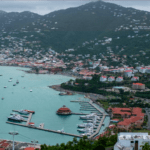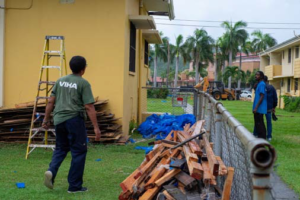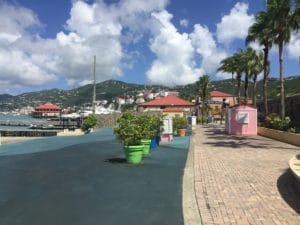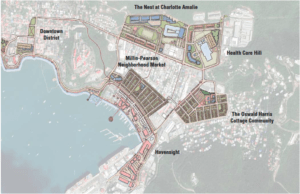 Date: August 25-30, 2019
Date: August 25-30, 2019
Location: St. Thomas, U.S. Virgin Islands
Sponsor: Virgin Islands Housing Authority, Virgin Islands Housing Finance Authority, Virgin Islands Economic Development Authority
Subject Area: Housing, Economic Development & Resilience, Placemaking & Mobility
Panel Chair: Adam Weers, Trammell Crow Company, Washington, D.C.
Download Report
Panel Background and Assignment
ULI was asked to consider and provide strategic recommendations on the following:
- Helping new communities become more resilient and reduce consumption of natural resources;
- Creating an equitable economic development vision for the next five, 10, and 15 years;
- Integrating the existing affordable housing stock into the surrounding neighborhood; and
- Creating a cultural theme and design principles to tie the area together and brand it as a unique location.
The panel’s work builds upon the work of an earlier ULI Advisory Services panel conducted in 2018 in St. Croix, which provided recommendations relating to building the island’s economic development, creating affordable housing, and improving transportation links and resiliency strategies. The islands’ environments and cultural makeup and needs are similar but separate due to geographic separation. The panel’s recommendations are a combination of specific plans and conceptual design suggestions for areas within its study area along with a suite of recommendations that broadly fall within the following five categories:
- Recovery and Resilience;
- Economic development;
- Housing;
- Built environment, placemaking, and mobility;
- Governance

Virgin Islands Housing Authority employees clear debris at the Paul M. Pearson Gardens housing site after Hurricane Dorian.
Credit: Laura Magruder/ULI
Addressing Recovery and Resilience
Approach: Harness Community Development Block Grant Disaster Recovery (CDBG-DR) funding to jump-start community resilience. Use the opportunity to make key shifts in the structuring and delivery of power in St. Thomas.
Recognizing resilience as a key economic infrastructure, the U.S. Virgin Islands (USVI) has demonstrated a longstanding commitment to sustainability and climate resilience. Any effort to rebuild should be founded in building to higher standards and not just re-creating the previous framework for resources that proved insufficient when stressed by extreme weather events.
The high cost of fuel in the USVI has hampered its economic growth, quality of life, and overall resilience. Energy is one of the major factors affecting economic development, health, education, transportation, quality of life, and the environment. People understand the importance of having access to affordable, reliable energy, but the fuel source is also a critical priority.
Key Recommendations:
- Harness CDBG-DR funding to jump-start community resilience and invest in energy alternatives including Solarize Thomas and focusing rebuilding efforts around integrated resilience measures to improve facilities.
- Strengthen commitments to USVI’s enactment of the Climate Change Adaptation Policy. As a result of this collaboration between the conservation and fisheries communities and the Departments of Planning and Natural Resources and Labor, the Virgin Islands Climate Change Adaption Policy addresses multiple sectors, including energy, agriculture, health, and critical infrastructure.
- Recognize resilience as a key economic infrastructure. Expand existing commitments to climate resilience by strengthening commitments to energy alternatives and supporting resiliency in new developments, particularly resilient initiatives backed with publicly supported partnerships.
- Explore decoupling and privatization of portions of the utility through the sale of the generation or distribution infrastructure to a utility company with the technical and financial means to transform the electricity system throughout the In conjunction with this effort, establish a public utility commission to lead regulation of utilities on behalf of USVI citizens.

View of St. Thomas from the Yacht Haven Grande area.
Credit: Paul Bernard/ULI
Addressing Economic Development
Approach: Focus on economic development investments at all scales in an effort to achieve greater diversification within the economy. The panel recommends investment in the downtown district paired with enhancements to tourism and small business development.
Tourism is the USVI’s largest employer, making the territory especially vulnerable to tourism-specific fluctuations. It is imperative that St. Thomas develop an equitable economic development plan that recognizes the value of human capital and the creation and growth of local small business activity.
St. Thomas has a generational opportunity to catalyze and leverage the responsible growth and diversification of its economy through an intentional, transformative economic development planning process involved with the development of the USVI 2040 Economic Development Plan.
From analysis of the study area, the panel offers the following recommendations that it believes would be of value to the study area and to the USVI 2040 Economic Development Plan initiative in addressing key economic challenges throughout the territory.
Key Recommendations:
- Bolster Charlotte Amalie. Support Charlotte Amalie as an economic catalyst by supporting and formally establishing a central business improvement
- Foster pathways to small business entrepreneurship. Take a small business approach as key in supporting equitable economic development that will most benefit
- Enhance tourism Enrich the visitor experience and create opportunities for overnight stays benefitting the local economy.
- Explore market-rate housing. Create pathways for sustaining area activity and diversifying the housing market.
- Be intentional about workforce training and placement. Develop local hiring and development requirements to meet the territory’s skill set needs.
- Create opportunities for public housing residents and other low-income residents. Expand small business and create pipelines to rehabilitation and construction work with the arrival of CDBG-DR funds.
- Use creative financing tools and partnerships. Support implementation of a more equitable approach to economic development through creative partnerships.
Addressing Housing
Approach: Use CDBG-DR funding as a catalyst for revitalization of public housing and creation of greater cohesion with the surrounding community.
Because of decades of declining federal subsidies, the Virgin Islands Housing Authority (VIHA) has not had sufficient resources to modernize the bulk of its properties. Nor has it received the necessary funds to protect and repair its properties from natural hazards and climate change. The increasing frequency and intensity of natural disasters make one thing clear: the future will bring more storms and more damage to the island, so rebuilding with an eye toward the future is vital.
As might be expected, many residents feel the burden of the cumulative impact of successive natural disasters and recurring structural challenges that manifests in many ways that are analogous to symptoms of trauma. Rebuilding offers the chance to address not only problems caused by the storms, but also some of the challenges that began beforehand and were exacerbated by natural disasters.
Because housing is one of the most fundamental human needs, the failure of the federal government to provide modernization and recovery funds in a timely manner negatively affects residents’ physical and mental health. Throughout the study, the panel was impressed with the resilient spirit and dynamic character that came through as panel members met with local stakeholders, including residents of VIHA properties, homeowners, business owners, and government leaders.
With the panel’s focus on key VIHA assets, it found the territory in a key position to revitalize public housing with an eye toward modernization, integration with the surrounding community, and strengthening social networks to assist residents in the advancement of the territory.
Given the depth of the panel’s analysis, the recommended approach centered on key housing and community challenges as follows:
Key Recommendations:
- Totally revitalize public housing. Seize the opportunity to design improved mixed-income and mixed-use communities by supporting increased density within the study Construct multifamily residences that are appropriately scaled, and incorporate retail and community space within walking distance to amenities.
- Address blighted properties with rehab grants and code enforcement. Create a robust plan to provide grants to seniors and property owners with disabilities, allowing them to make repairs, and designate immediate measures to enforce codes.
- Focus on revitalization without displacement. Make it a practice to revitalize within the study area while limiting displacement and creating open indoor and outdoor multi-use space for the community.
- Ensure that revitalized areas include play spaces for children. Foster greater community through creating places for the youngest residents.
- Enhance service, civic, and social networks. Build trust and social capital by creating conversations and networks to foster distinguishably rich civic culture allowing for continuous community engagement.
- Recognize the connectivity and integration of health and housing through the prioritization and implementation of recommendations from the 2019 Community Needs Assessment. Support community health challenges as a mechanism to tackle the needs of and achieve tangible outcomes for the most vulnerable populations.

The panel’s vision for the study area built environment.
Credit: Dan Anderton/ULI
Addressing the Built Environment, Placemaking, and Mobility
Approach: Improve quality of life through reunifying and connecting surrounding communities by placing residential at the core of the vision. Within the greater scope of the downtown Charlotte Amalie district, the panel’s conceptual drawings make an effort to use the built environment, placemaking, and mobility enhancements to bridge its various areas.
Key Recommendations:
- Recognize and celebrate Thomas’s unique culture by tying themes into placemaking. Leverage key opportunities to acknowledge the inherent value of the existing community and tie in cultural themes and design principles throughout the areas of downtown Charlotte Amalie, Havensight, and the VIHA properties to brand them as a unique location.
- Improve health and quality of life through mobility enhancements. Encourage a culture less reliant on use of personal vehicles by enhancing modes of connection between neighborhoods, enabling the USVI to be eligible for federal transportation funds for transportation alternatives, and improving the bike and pedestrian experiences.
- Reinforce built environment concepts. The conceptual vision reinforces the vitality of the overall community by enhancing existing strengths within its The concept demonstrates key placemaking and mobility recommendations throughout, allowing for greater connectivity within the districts, and primes the area as “St. Thomas’s Front Door.” Although the visuals are limited to the overall study area for the panel, the approach strengthens the experience along Veterans Drive by leveraging enhancements to the corridor and setting up a promenade to the airport and port sites located to the west.
- The Nest at Charlotte Amalie—Enrich key education facilities as an anchor within the neighborhood and boost residential appeal to the greater neighborhood.
- Health Care Hill—Augment and consolidate the hospital site, adding complementary uses such as senior housing and accessory medical uses.
- The Oswald Harris Cottage Community—Generate multifamily housing density that complements its surrounding context while aligning key commercial assets along Veterans Drive and incorporating community facilities centrally.
- Millin-Pearson Neighborhood Market—Reposition and mirror commercial activity along Veterans Drive by promoting accessibility to and from the Modernize Millin residential community and create outdoor improvements throughout the site.
- Havensight—Cultivate an enhanced vending experience along the streetfront together with modifications to parking strategy and attention to treatment of pedestrian and bicycling infrastructure.
- Downtown District—Cultivate the pedestrian experience along Veterans Drive, thereby attracting more connectivity between residential and commercial centers by investments in transportation, parking facilities, and shade Enrich the Emancipation Garden park environment allowing for visibility along Veterans Drive and creating space for community and events sponsored by the business improvement district.
Addressing Governance
Approach: Evaluate structural and governance barriers, implementing reform and ensuring a high level of delivery and implementation in the context of the disaster recovery funding and new administration.
Some USVI impediments have to do with structural and organizational barriers to progress within the USVI government itself. Although many of these challenges are longstanding and are neither the creation nor the fault of current government officials and administrators, they are real and prevalent: the time for reforming, addressing, and restructuring them is now.
The current USVI government has an opportunity to accept this reality for what it is and acknowledge that whereas the links may be inaccurate, the rhetoric may be deplorable, and the motivations may be questionable, the current governance challenge, if responded to in a material way, can provide a road map to justify a demand for access to more recovery dollars in a more timely manner as a result of the USVI’s response. Simply put, there are times in dealing with governmental gatekeepers when it is prudent to be disagreeable but responsive.
This section provides suggestions to the leadership of the VIH and the USVI government on how to address the issues mentioned above.
Key Recommendations:
- Improve coordination among agencies. Better serve and support VIHA’s mission by increasing coordination with other economic development and housing agencies through enhancing an economic development and disaster recovery cluster under the purview of the governor.
- Reinforce comprehensive planning functions within the territory. Create and regularly update a comprehensive plan to promote greater development and land use control that allows greater efficiency and opportunities to leverage cohesion.
- Position for attraction of skilled talent. Create a new at-will category of mid-level management workers to attract the most qualified skilled talent. Incentivize youth graduating from the University of the Virgin Islands and those across the diaspora to serve the territory.
- Engage community. Increase engagement and participation of residents in planning for housing and economic development issues in the territory through an office on community engagement.
- Bolster confidence in leadership. Ensure that appropriately skilled individuals, regardless of political affiliation, are well suited for and performing within their positions through new civil service classification for management workers, extending to independent agencies such as Best practices include the following:
- Pursue honesty and transparency in communication and benchmarking throughout processes.
- Ensure strategic and organized planning occurs at all levels of government.
- Enlist a skilled team that supports and meets critical needs to position the strategic vision for success.
- Demonstrate delivery and implementation on strategic vision at multiple scales.
